Stories
Dressing up the New Zealand Sound
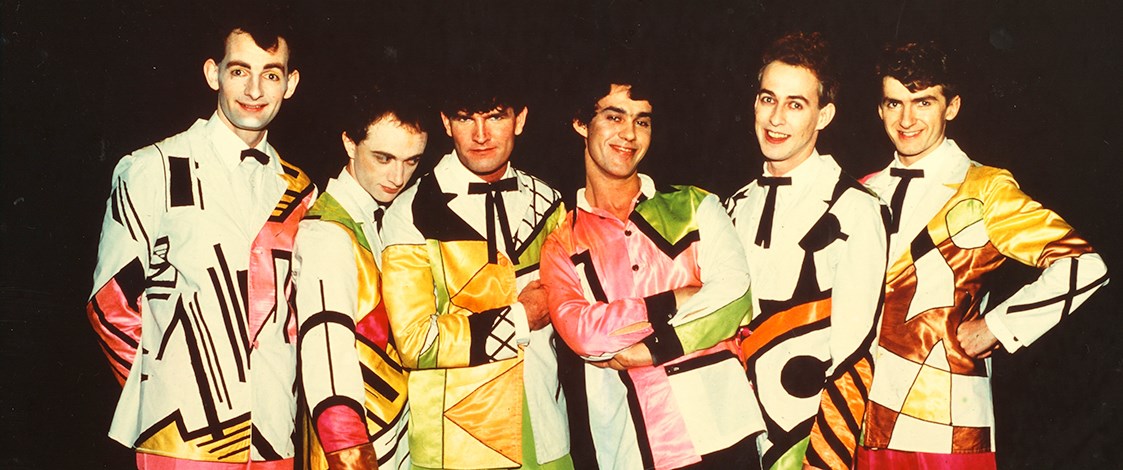
We know what New Zealand music sounds like - but what does it look like? A song may begin with a few strums on a guitar or some catchy beats, but once it is performed it becomes more than what you can hear.
Lyrics aren't the only channel for getting a message across. A musician's look can champion a cause, turn heads, influence audiences or remind a rising star of where it all began.
It is a now-famous leather jacket that connected The Chills' Martin Phillipps to the past. Normally associated with toughness, his jacket became the subject of a song written to honour its previous owner, bandmate Martyn Bull who died of leukaemia in 1984.
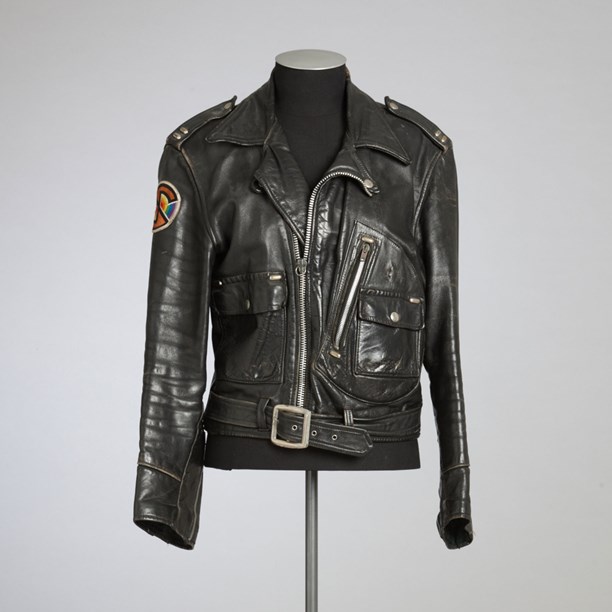
The Chills etched their way into the New Zealand rock consciousness in 1986 with 'I Love My Leather Jacket', written by Martin Phillipps.
Best dressed
Sophistication, style, and matching outfits - it's a look that demands attention and adds a large dose of star power to the stage.
Tami Neilson is one such star who goes for this look. In the music video for her 2016 song 'Lonely', Tami is the essence of old-school elegance, dressed in a black velvet gown with a fishtail and white gloves. Designed by Judy Dee of Curvy Couture, the ensemble is straight out of one of fashion's most glamorous eras, 1950s Hollywood.
Tami Neilson featuring Marlon Williams, 'Lonely', 2015..
Judy also worked with Tami to design a striking yellow dress and coat trimmed with feathers for the 2016 Vodafone New Zealand Music Awards. "I absolutely love making clothes for Tami, Judy says. "She presents my dresses exactly as I would like them to be worn. I get really excited when I see her in magazines, newspapers, and on TV. It's a very humbling experience as I am a one-person operation."
Marlon Williams - who features on Tami's song 'Lonely' - is another artist who gravitates to old-school fashion. His style references 1950s 'greasers' or you can also see him reinterpreting the country music uniform of checked shirts and string ties. His look complements his music, which is described by Under the Radar as having 'a timeless and sensitive quality'.

Marlon Williams, 2014. Photo by Justyn Denney.
But for New Zealand musicians performing in the 1950s, the style was far from 'greaser'. These bands may have been branded a bad influence, but most parents wouldn’t have disapproved of the attire of the our first rock 'n' roll stars. When they took to the stage, Johnny Devlin & the Devils, Max Merritt and The Meteors and Ray Columbus & The Invaders were impeccably dressed in suits, ties, and polished shoes.
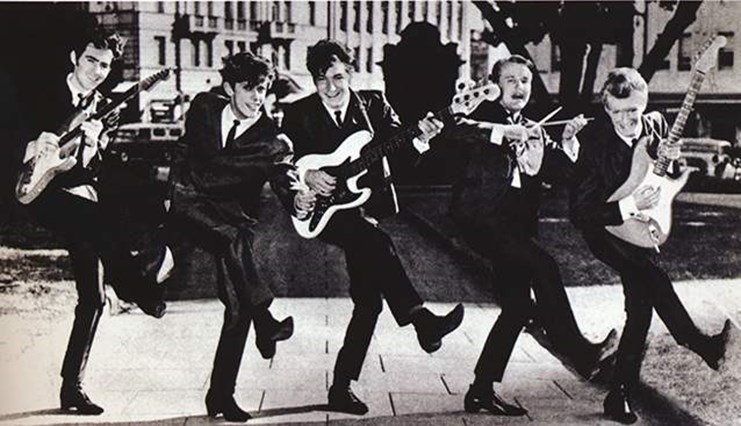
Ray Columbus & The Invaders in Sydney, courtesy of AudioCulture.co.nz.
Immaculate glam
Mahora Peters, lead singer of the popular showband The Maori Volcanics, alternated between glitzy cocktail outfits and versions of Māori and Pacific dress - a piupiu, bodice, and headband or a hula skirt and lei. The band travelled all over the world, giving Mahora plenty of opportunity to shop for dazzling stage attire.
In outfits made by their dressmaker Mrs Ali Verhoek, the soul-singing Yandall Sisters brought a glamorous prescence to the stage. "Our mother instilled in us to always try and look good when going out and our agent Elaine Hegan also told us that when we performed we should always be the best-dressed women in the room, so we never forgot that," Adele Yandall recalls.
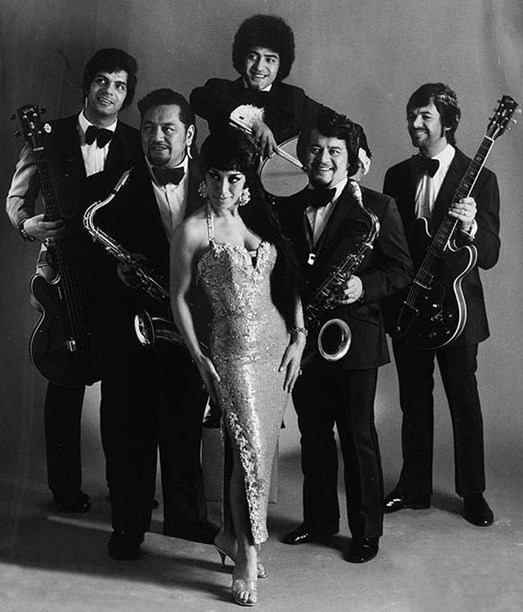
The Maori Volcanics, with Prince Tui Teka, Rim D Paul Collection, courtesy of AudioCulture.co.nz.
Meanwhile a young singer from Dargaville, Mark Williams, was making his own costumes. "I felt it was important that not only do I sing but that I looked like something. Visual was very important to me."
Mark Williams, 'Yesterday was just the beginning of my life', 1981.
Black is a beautiful colour
On the flipside, black clothing is a wardrobe staple for many New Zealand musicians. But is it a deliberate act of nonconformity or just indifference towards the world of fashion?
The meaning of wearing the colour black has a complicated history in New Zealand. It encompasses mourning protocol, uniformity, formality, and values of temperance. On the other hand, it represents modernity, nonconformity, and protest. These meanings were explored in the 2011 exhibition Black in Fashion and the subsequent book Black, which explored the roles dark colours have played in New Zealand music.
As New Zealand entered the 1970s, wardrobes were made up of a palette of bright colours. "Black was really only worn at the margins: by the guardians of the prevailing civil code, the men in authority; by those practising dissent, the rebels; and by those proposing change, the avant-garde," says Black in Fashion curator Doris de Pont.
But there was plenty of dissent happening in 1970s Ponsonby. Bands like Dragon and Hello Sailor were donning black leather pants and biker jackets, the latter group providing the anthem 'Gutter Black'.
Hello Sailor, 'Gutter Black', 1977.
And there was a rising tide of political awareness and a call for change. As Andrew Clifford notes in Black, when Herbs - a group with mixed Polynesian and Māori membership, and associations with the Black Panther movement - released their first album Whats' Be Happen, they chose to shed the sunny colours and island imagery usually associated with reggae music. The album cover featured a black and white photo of the 1978 Bastion Point eviction day.
Down south the Flying Nun bands adopted an 'alternative' uniform - variations on a black woollen jersey, leather jacket and dark jeans. But the black jersey was more of a practical choice than a fashion statement. "It was f**king cold down there, and it was cheap clobber; Warnock's had them by the lorry load and they were easy to wash" recalls writer and music reviewer Grant Smithies "It was wearing what you got up in that day rather than any kind of fashion statement."
When The Chills recorded the album Soft Bomb with American label Slash in 1992, they wanted to capitalise on the popularity of the Dunedin Sound and produced a woollen jersey as a marketing gimmick to help promote the album.
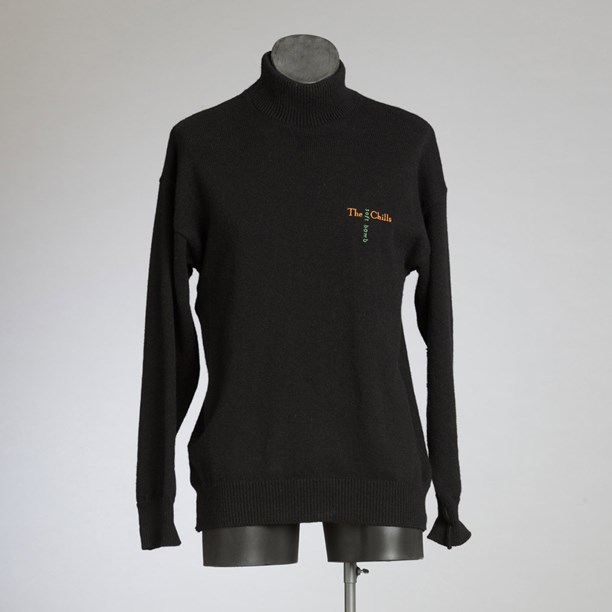
The Chills' 'Soft bomb' black jumper.
Shihad's Jon Toogood says the band worked out early on that black looks good with everything and could even "make a bunch of nerdy metalheads from Wellington look sorta cool. Wearing black also made us look and feel like an unified gang, all on the same mission without really that much effort. As long as you had a black t-shirt and black jeans you were ready for battle."
Supergroove adopted the colours black, red, and white in a deliberate attempt to brand the band. Their logo, posters, album covers, music videos, and clothing all stuck to this palette. Each band member wore a personalised outfit made by fashion label Feline - a hoodie, long-sleeved top, and pants. "We wore them on stage and into town. It made us a feel like a real band, like a gang I guess," says Nick Atkinson.
Supergroove, 1993, photographer Polly Walker, ©Sony Music; Nick Atkinson’s tracksuit top and bottom, and t-shirt about 1993, made by Feline, courtesy of Nick Atkinson, photographer New Zealand Fashion Museum.
The concept recalls the bands of the 1950s and their matching stage attire. But by the time they released their second album, Supergroove had abandoned the red and adopted formal 'men in black' suits. Watch the video for 'You Gotta Know' to check out the black, red, and white in full splendour.
Supergroove, 'You Gotta Know', 1994.
Costumes and kookie clothes
For some musicians, the alternatives of a sharp suit or a uniform of black wasn't enough. Instead, fashion was a way to stand out from the crowd or an opportunity to be someone else.
Dinah Lee changed her name … and her look in 1964. Not long after moving to Auckland, Dinah befriended Jacky Holm who worked in one of the city's most 'out-there boutiques', The Casual Shop. Teenagers loved her fresh image and copied it - despite the protests of parents across the nation.
A decade later and New Zealand had undergone a revolution. 1970s fashion was a sea of long hair, hand-painted tunics, and flared jeans. But a few bands deliberately avoided that look; they were determined to be noticed. By 1974, TV was still seen as a way to get your music 'out there', but the talent show-style programmes were often uninspiring. The appearance of Alistair Riddell, however, was revolutionary. "Into the living rooms of the nation strides a tall, androgynous figure with dark tresses, silver eye shadow and white satin bell-bottoms," wrote Nick Bollinger for AudioCulture.co.nz. "His scarf trailing almost to the floor, he pouts and preens his way through an ode to a drag queen."
Space Waltz, 'Out on the Street', 1974.
Split Enz were opening for Space Waltz at Hamilton's Founders Theatre when they introduced the look made them as distinctive visually as they were musically. Seamster Noel Crombie joined in 1974, bringing with him a bulky suit carrier and a vision for a groundbreaking visual style.
Split Enz, 'Things', 1979.
"We were dedicated to isolating ourselves from anything remotely resembling what the rest of the musicians in the country were up to," recalls Mike Chunn in the book Stranger than Fiction.
Material matters
Punk's anti-establishment aesthetic meant accessorising yourself in everyday industrial materials, dressing in op-shop garments, or borrowing your mum's sewing machine to whip up something new. Vinyl aviator suits, space-age sunglasses, barbed-wire armbands, and gas masks were just some of the garments seen on stage.
When Proud Scum changed their name to the Beagle Boys they had orange jumpers made – replicas of those worn by the Disney criminal gang the band named themselves after. Jonathan Jamrag's sister made them on her knitting machine.
After punk came bands more influenced by pop, and inspired by new wave music. Among these were the Mockers. Frontman Andrew Fagan says in their 'quest to find an audience they had a lot of fun playing live and challenging the orthodox approach to how you should look on stage'.
Mockers, 'Alvison Park', 1983.
Mockers fans might remember Andrew's spectacular pink fluffy suit from the 'Alvison Park' music video, or from their 1983 tour. "Wearing the pink fur suit on stage under the lights always resulted in it getting absolutely saturated with sweat," recalls Andrew. "Each morning, it would be crispy dry and reeking of stale sweat. At the end of the six-week tour it still looked good but the other band members seemed to keep their distance from me, for obvious reasons."
Creating a spectacle is just as important to South Auckland band Vallkyrie. They may look culturally overloaded but their mix of kimonos, Egyptian headpieces mixed with medieval armour and G-shock watches is all about aesthetics and big striking statements.
Vallkyrie, 'Voodoo', 2016.
The band have designed their own piece of branded fashion, based on the tare - a Japanese martial arts belt that features a name tag. "We make all our branded clothing ourselves, we go to our local clothing printer in Manukau mall. He sees us and smiles and he says 'Ooh BIG V, Old English, 13inch'. Eventually we will start making merchandise and getting it manufactured in bulk so we can sell to the many."
The band t-shirt
It only took a decade for the band t-shirt to morph from an item given gratis to a band's inner circle to a product sold across the nation.
As a pirate radio station broadcasting from a ship anchored offshore, Radio Hauraki was soon looking for income to keep them afloat. In 1966, they were selling branded t-shirts and merchandise through their formal network of listeners, The 1480 Club.
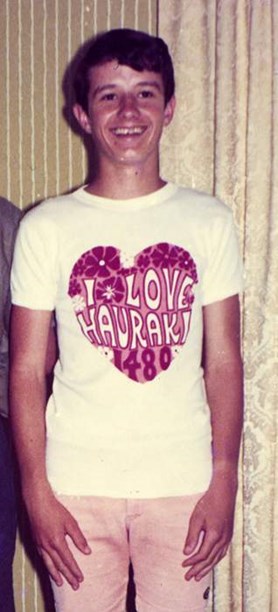
Murray Cammick wearing his Radio Hauraki t-shirt, courtesy of AudioCulture.co.nz.
One of the first studio guests on Radio Hauraki was the band Larry's Rebels. They also printed t-shirts showcasing their name. Magazines such as Groove included coupons which readers could send away for t-shirts. "We didn't wear t-shirts to perform - we wore suits and shirts - but we gave away Larry's Rebels t-shirts to people who helped us out," recalls band member Terry Rouse. "They were also for sale through our fan club."
Screenprinting t-shirts was a relatively new industry in New Zealand, and the demand was small. The cost limited early designs to one or two colours.
Larry's Rebels lead singer Larry Morris went on to open a t-shirt screenprinting business, Crazy Shirts, with promoter Hugh Lynn and architect Jim Stoneman in 1972. Local bands such as The La De Da's and Herbs ordered the branded t-shirts as a form of self-promotion.
Screenprinting businesses soon popped up in New Zealand's main centres. Check out the t-shirt Richard Egan wore as lead singer of the Bulldogs Allstar Goodtime Band when they performed on the children's series Spot On in May 1974.
Bulldogs Allstar Goodtime Band, 'Dance the Stars Away', 1974.
Crazy Shirt's Hugh Lynn recalls fans bringing in their own designs for custom t-shirts featuring their favourite band. Wearing a band t-shirt quickly became a means of self-expression.
Bootleggers caught on to the potential fan market and printed hundreds of t-shirts that were sold at festivals and markets. But before long, bands and their promoters realised the moneymaking potential of merchandise and began to license their branding.
Businesses like Crazy Shirts found a new market manufacturing t-shirts under contract; while design firms like Snake Studios found new clients in record companies - making t-shirts for international bands including Alice Cooper and Little Feat to be sold at their New Zealand shows.
By the 1980s, both the industry and the style had evolved. T-shirts featured brighter and more complex prints - often based on graphics from album covers or tours. They were part of a branded package.
DD Smash's Dave Dobbyn designed the t-shirt for their 1985 tour using the graphics from their single, 'Magic What She Do' as inspiration.
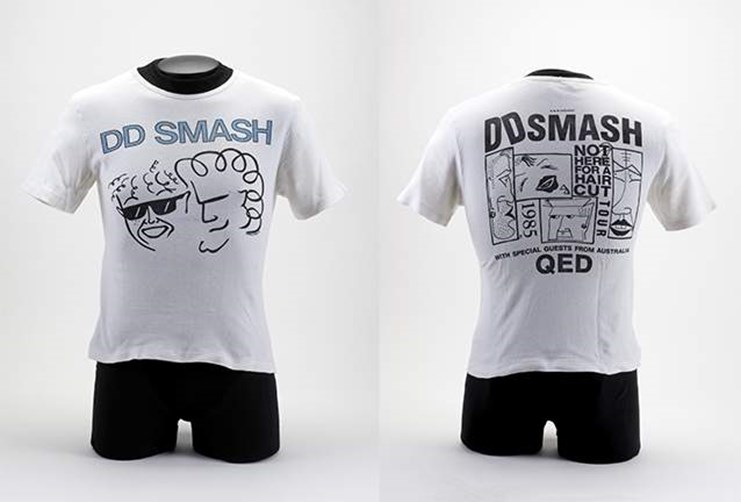
DD Smash T-shirt, 1985, designed by Dave Dobbyn, on loan from Dave Dobbyn, photographer Auckland Museum.
Comic artist Martin Emond was involved in the artwork for two Hallelujah Picassos albums - the design on this t-shirt first appeared on the inside cover of their 1995 EP, Gospel of the DNA Demon, and portraits he did of the band appeared on the booklet for their second album. Martin later worked with Shihad, Head Like a Hole, and Danzig, and with the clothing label Illicit.
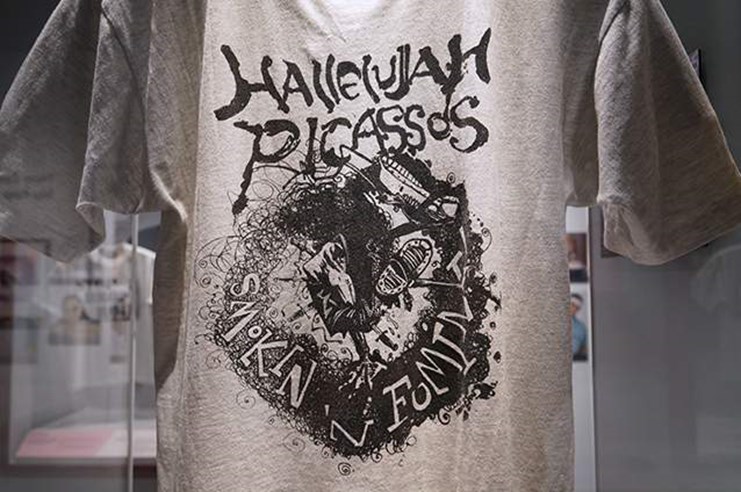
Hallelujah Picassos' T-shirt on display in Volume. Designed by Martin Emond, 1995, on loan from Peter McLennan and Hallelujah Picassos.
'Martin's later artwork in comics such as White Trash and Lobocop (published by Marvel) featured visual references to Hallelujah Picassos, such as our Black Spade Picasso Core logo. We were dead chuffed," says band member Peter McLennan.
Dawn Raid Entertainment built an empire on the back of selling t-shirts. School friends Andy Murnane and Danny 'Brotha D' Leaoasavai‘i began selling T-shirts at the Ōtara Markets in the late 1990s, and used the profits to fund Dawn Raid's first release, the compilation Southside Story. Mareko's 'Stop, Drop and Roll' t-shirt was just one of many oversize styles from the Dawn Raid catalogue.
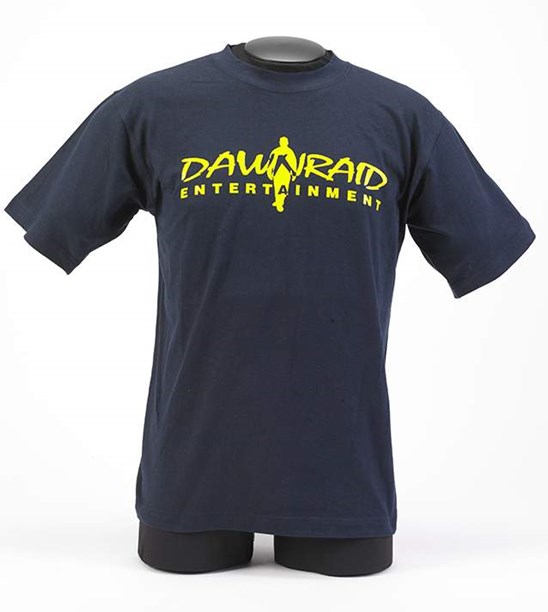
Dawn Raid Entertainment, 2003, made by Dawn Raid Entertainment, collection of Auckland Museum, 2003.115.1.
Wellington's Mermaidens are lucky enough to have their own artist in the band - bassist Lily West is a talented illustrator. She designed the first Mermaidens T-shirt in 2015, a cosmic vibrating being surrounded by floating plants and other creatures.
Flipping the usual process, Lily's t-shirt design was used on the cover of Mermaidens' first album, Undergrowth. Elements from the design can also be seen in the animated music video Lily created for 'Under the Mountain II'. The band says there is nothing cooler than seeing a stranger walk down the street wearing your band t-shirt. But there's a more practical side to selling T-shirts adds vocalist/guitarist Gussie Larkin. "They're a pretty good money maker. We definitely make them for our friends and fans to enjoy - and to be walking billboards!"
The story of the band t-shirt has come full circle with Slash from Guns N' Roses spotted wearing muscle tank from Raglan-based label Bad Things. No longer about proving you were at the show, the band t-shirt has become the centrepiece of rock 'n' roll style - adopted by celebrities and the public alike.
Trendsetters
When musicians and fashion designers realised the crossover potential of their respective creative industries, the fashion-music collab was born.
The arrival of TV in the 1960s introduced a new audience to New Zealand music. Artists quickly saw the potential of broadcasting into homes all over the nation, and they relied on local fashion designers to make sure they looked good. TV had a massive influence. Outfits worn by musicians on a Saturday night show were quickly replicated on the street.
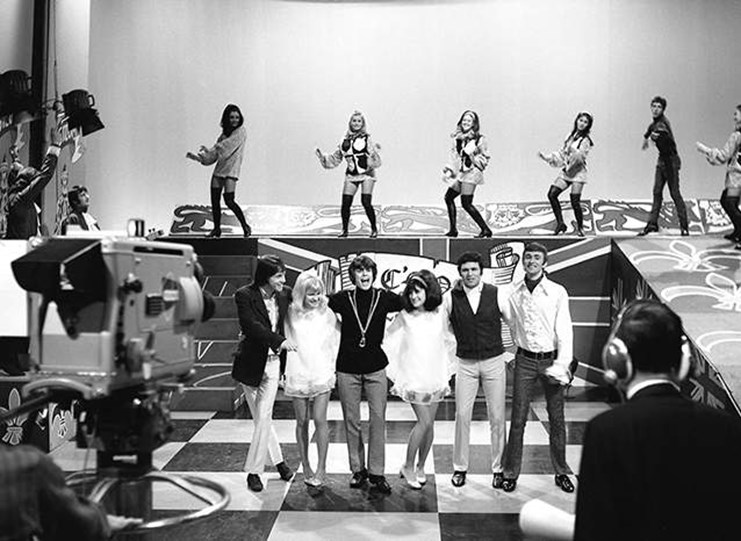
Dress rehearsal for the C'mon season finale, 1968, photo by Bruce King.
Designer Annie Bonza returned from Sydney to Auckland in the 1960s, quickly becoming one of the 'it' designers. Annie's graphic style was made for black and white TV. Working closely with artist Murray Grimsdale, she designed outfits for the Music Hall and C'mon shows - sending finished garments to the set by taxi. "The exposure was huge but we were so busy creating that we didn’t have time to think about it," says Annie. "We wanted to keep a constant flow of new garments for girls to choose from.'
Regular C'mon performers The Chicks remember Annie for her 'different, way-out clothes'. 'She was way ahead in the fashion field,' remembers Judy Donaldson. But the sisters were only teenagers and they didn’t have much influence over their look. 'We were very young at that stage. I was 16 and Sue was only 13, so we didn’t have much say in anything. It was our manager Ron Dalton who "created" The Chicks image.'
With her 26-week residency on C'mon, Sandy Edmonds was soon a household name. Her long blonde hair and teen-sullen pout meant she was sought after as a face of fashion - Sandy advertised make-up and appeared in fashion spreads for the New Zealand Woman's Weekly.
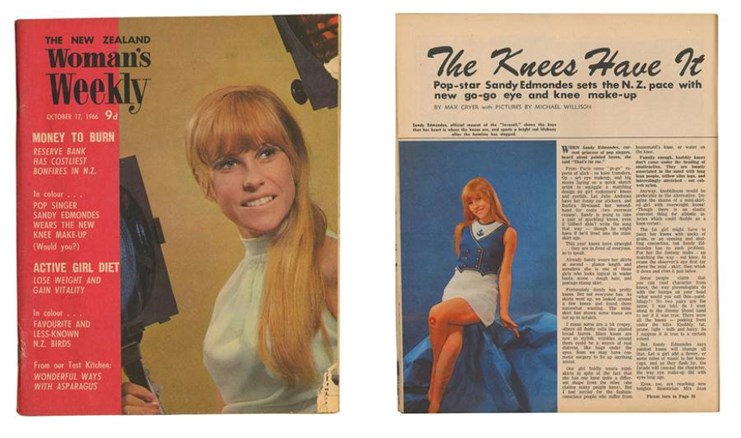
'Pop singer Sandy Edmonds wears the new knee make-up (Would you?)', New Zealand Woman's Weekly, 17 October 1966. Image © Bauer Media Group.
Sought-after style
Excerpt from Popstars, Season 1, Episode 3, courtesy of NZ On Screen.
While True Bliss resisted (unsuccessfully), the rise of visual-based media is only adding to the importance of nailing your image. Collabs between musicians, stylists, and designers are mutually beneficial - the designer's brand is exposed to a new audience and the musician looks amazing.
Ladi6 recently collaborated with Sera Mitchinson and Kowtow Clothing to design a garment that she described as representing her music life story. Designer Shona Tawhiao describes Ladi6 as having her 'own cool style' - something that attracts designers keen to see their clothes worn by artists who exemplify values such as strength and individuality. Often wearing dresses by Lela Jacobs or Tanya Carlson, Ladi6 pulls it all together with carefully chosen accessories like a Shona Tawhiao kupenga harakeke neckpiece paired with a top hat or statement jewellery by Nina Gordon.

Ladi6's Lela Jacobs dress.
Since 2005, Aaradhna has worked closely with sisters Sophie and Marissa Findlay, whose parents Liz and Neville started the fashion label Zambesi in 1979. "For me it feels like I'm working with family," Aaradhna says. "It feels comfortable and I love their honesty and their eye for details. I trust their eyes they know what looks good and what's a no-go. Love working with Zambesi and getting to wear some of their amazing clothes and I love Liz, she's a beautiful spirit. The whole famz are!'
Sophie directed two of Aaradhna's most recent videos, 'Brown Girl' and 'Welcome to the Jungle', with Marissa as director of photography. "We love working with Radz, it benefits Zambesi of course to work with her as she speaks of equality and strength and she oozes style and confidence through her image... we share those same ideas," says Marissa. "We have always loved supporting New Zealand artists when we can. As a photographer it's great for me as people see my work through Aaradhna's popularity. I also just LOVE Aaradhna on a personal level. She is an amazing human and of course stunning to photograph. Sharing the love and the collab works well both ways."
Aaradhna, 'Brown Girl', 2016.
They might not always write songs about their leather jacket, but musicians are very aware of the importance of their identity. Pictures are now firmly part of the package - the album cover, the music video, what a musician wears to perform - it all adds up to tell the story of the music.
Text by Kelly Dix for Auckland Museum's Volume exhibition, 2017. Text © Tāmaki Paenga Hira Auckland War Memorial Museum. Banner image of Split Enz in their UVs suits, 1980, courtesy of Split Enz Archives.
First published February 2017, updated May 2019.